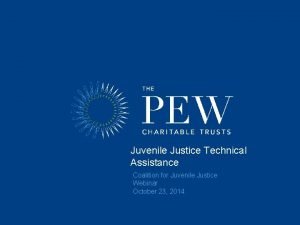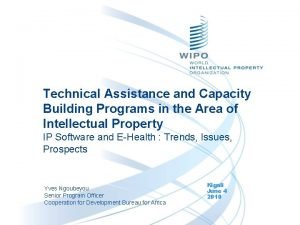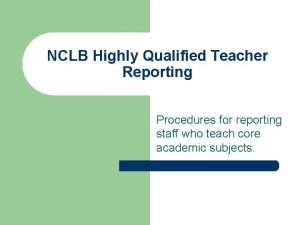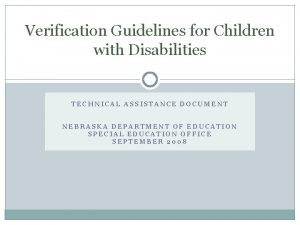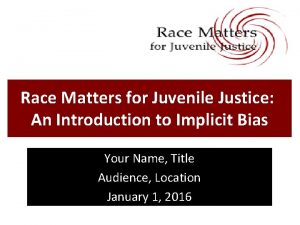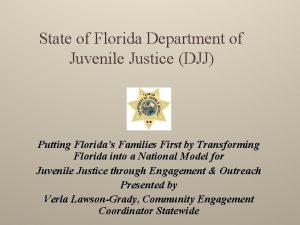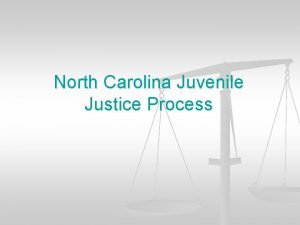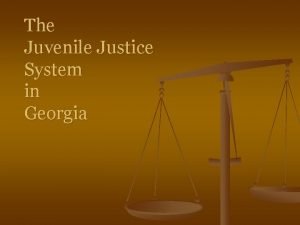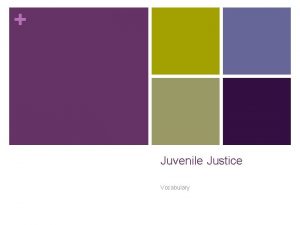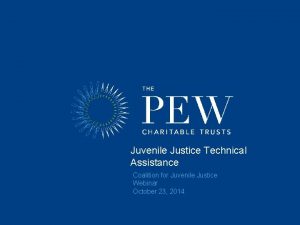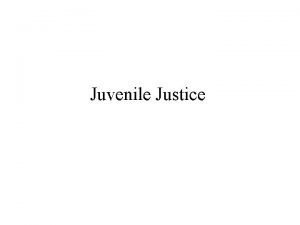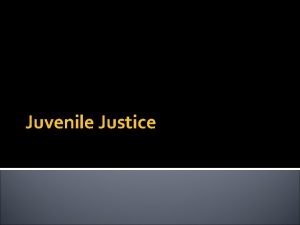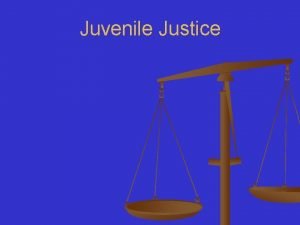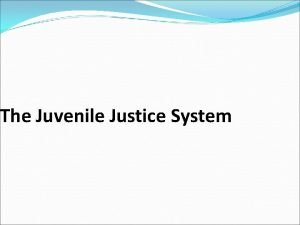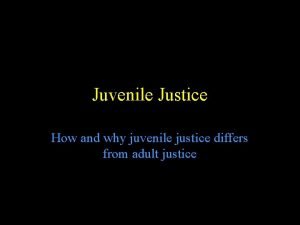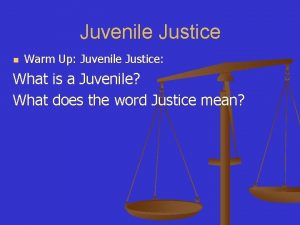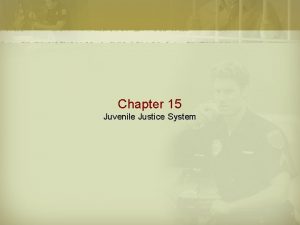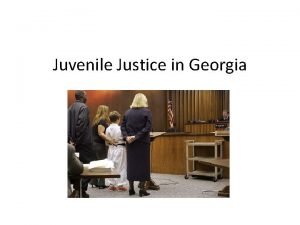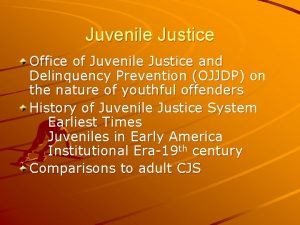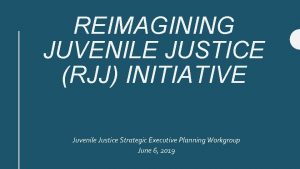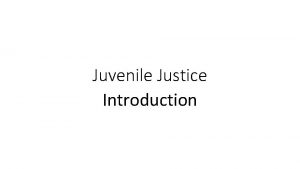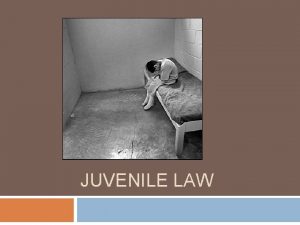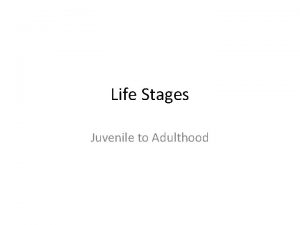Juvenile Justice Technical Assistance Coalition for Juvenile Justice



















- Slides: 19

Juvenile Justice Technical Assistance Coalition for Juvenile Justice Webinar October 23, 2014

The Pew Charitable Trusts is a nonprofit organization that applies a rigorous, analytical approach to improve public policy, inform the public, and stimulate civic life. Pew’s public safety performance project works with states to advance data-driven, fiscally sound policies and practices in the criminal and juvenile justice systems. 2

Public Safety Performance Project Works with states to examine their juvenile justice systems to get a better public safety return on their juvenile justice spending. States are focusing on: § Protecting public safety by improving outcomes for youth, families and the public § Holding juvenile offenders accountable § Controlling juvenile justice costs 3

Process of Pew’s Technical Assistance State selection Task force facilitation Legislative assistance Implementation support 4

State Selection: Alignment of Goals Undertake a comprehensive analysis of West Virginia’s juvenile justice system and data, and develop system-level recommendations, including proposals for statutory, budgetary, and administrative changes, to protect and promote public safety by –Improving outcomes for youth, families, and communities –Enhancing accountability for juvenile offenders and the system –Containing taxpayer costs by focusing system resources on serious juvenile offenders 5

Task Force Facilitation: Membership Executive branch • Governor/Governor’s Designee • Juvenile Justice agency director • Children and Families agency director Judicial branch • Chief Justice/Designee • AOC Director • Judges • Probation Legislators Stakeholders • Education • Prosecutor • Defense attorney • Law enforcement • County officials or local government 6

Task Force Facilitation: Key Components State selection Task force facilitation Legislative assistance Implementation support Step 1: Data analysis and system assessment Step 2: Policy development Step 3: Consensus building Ongoing: Stakeholder engagement 7

Task Force Facilitation: Report “The task force was vital to the process because it gave us that credibility and that unified voice to speak with when rolling out a package of legislative reforms. ” John Tilley, Kentucky House of Representatives Judiciary Chair, Task Force Co-Chair 8

Legislative Assistance Georgia: HB 242 House: 173 -0 Senate: 47 -0 Governor signed on May 2, 2013 Reinvestment: $5 million Hawaii: HB 2490 House: 50 -0 Senate: 24 -0 Governor signed on July 2, 2014 Reinvestment: $1. 26 million Kentucky: SB 200 House: 84 -15 Senate: 32 -6 Governor signed on April 25, 2014 9

Key Information Pew Provides Data Analysis Research State Examples 10

Data Analysis: Findings For example, in Georgia, the data revealed § Low-level youth in out-of-home placement: 45 percent of youth in nonsecure residential beds were misdemeanants, 8 percent were status offenders; § Increasing length of stay: Between 2002 and 2011, designed felon length of stay increased 13 percent; § Poor outcomes: 65 percent of youth released from those beds recidivated after three years; and § High taxpayer costs: Each secure bed cost Georgia $90, 000 per year. June 30 th, 2011 Snapshot, Non-Secure Residential Placement in Georgia Status 8% Misd. 45% Felony 47% 11

Data Analysis: Implications “It was a surprise to learn the facts about our juvenile population because you want to think that you are just committing those ‘bad’ kids and the fact is we really weren’t. ” Judge Lisa Jones, District Court judge, Daviess County, Kentucky “When I started to look at the type of kids that we had at the correctional facility, I realized that the overwhelming majority of them were not a risk to public safety. So why did we have them in a correctional facility? Which got me looking at our entire system, and realizing that reform was just a must. ” David Hipp, Executive Director, Office of Youth Services, Department of Human Services 12

Research: High Cost, Low Return of Residential Placements, Importance of Community Options Residential placements: • Generally fail to produce better outcomes than alternative sanctions, • Cost much more, and • Can increase reoffending for certain youth. Community programming and practices are effective when systems: • Use evidence-based tools, • Match placement, supervision, and treatment to risk and need, • Include treatment with surveillance, and • Ensure quality service delivery Kentucky was spending its money in all the wrong ways. We were spending a lot of money on detention, particularly for low-level offenders, when we see that's not a productive or an effective way to invest in the lives of those kids. ” Whitney Westerfield, Kentucky Senate Judiciary Chair. 13

State Examples: Focus Out-of-Home Facilities on Higher-Level Offenders Georgia Creates a two-class system within the Designated Felony Act Prohibits status offenders and certain misdemeanants from residential commitment Kentucky Establishes an alternative, pre-court process for status cases Restricts commitment of lower-level felony offenders and misdemeanors Limits the length of out-of-home placement and length of supervision based on seriousness of the offense and risk to reoffend Requires graduated sanctions for probation violations and limits out-ofhome to 30 days. Hawaii Prohibits misdemeanants from HYCF placement 14

State Examples: Build Community Options that Reduce Recidivism Georgia Establishes a voluntary fiscal incentive grant program Require evidence-based practices and assessments Allow lower level youth onto administrative caseloads Kentucky Requires use of objective, evidence-based tools in decision-making Create fiscal incentive program Increases engagement and accountability of families Hawaii Require validated risk and needs assessment, case planning, sanctions and incentive system Allow earned discharge from probation 15

State Examples: Enhance Oversight and Ensure Performance Georgia Continue oversight with GA Council on Criminal Justice Reform Require performance-based contracting Require uniform data collection and tracking Kentucky Requires improved data collection and reporting to measure outcomes Establishes an Oversight Council Increase training and education Hawaii Requires enhanced data and outcome reporting Creates a Juvenile Justice Oversight Advisory Council 16

Anticipated Results Over First 5 Years Georgia: Population: Reduced by 31% Savings: $85 million Kentucky: Population: Reduced by 37% Savings: up to $24 million Hawaii: Population: Reduced by 60% Savings: $11 million “…the most important change was ensuring that judges only send a kid to our secure facility, the Hawaii Youth Correctional Facility, if he is a threat to the public. Period. ” Judge Mark Browning, Hawaii Family Court Judge. 17

Exploring Whether this Process is Right for Your State • What’s the problem/issue your state would tackle? • Is this the right time for state leaders to address that problem/issue? 18

Contact: Robin Olsen Manager, State Policy, Public Safety Performance Project The Pew Charitable Trusts (202) 540 -6603 rolsen@pewtrusts. org 19
 Coalition for juvenile justice
Coalition for juvenile justice Sample technical assistance given to teachers
Sample technical assistance given to teachers Sample technical assistance for teachers deped
Sample technical assistance for teachers deped Nde rule 51 technical assistance document
Nde rule 51 technical assistance document Fda technical assistance network
Fda technical assistance network Sample technical assistance given to teachers
Sample technical assistance given to teachers Race matters for juvenile justice
Race matters for juvenile justice State of florida department of juvenile justice
State of florida department of juvenile justice Juvenile justice system in georgia
Juvenile justice system in georgia North carolina juvenile justice
North carolina juvenile justice Unit 2 criminal law and juvenile justice
Unit 2 criminal law and juvenile justice Expulsion
Expulsion Minnesota juvenile justice system
Minnesota juvenile justice system R.a. 9344
R.a. 9344 Georgia juvenile justice system
Georgia juvenile justice system Juvenile justice vocabulary
Juvenile justice vocabulary Juvenile justice act 2000
Juvenile justice act 2000 Strategi för svensk viltförvaltning
Strategi för svensk viltförvaltning Sura för anatom
Sura för anatom R formel
R formel
